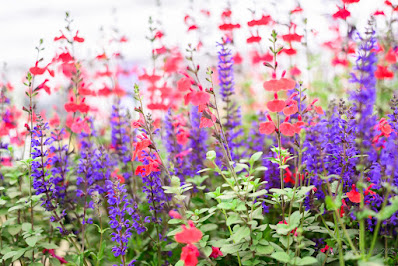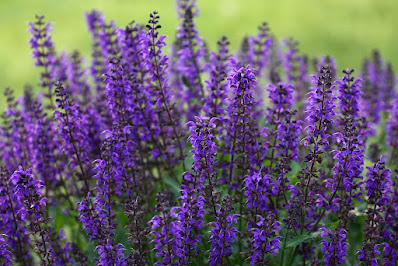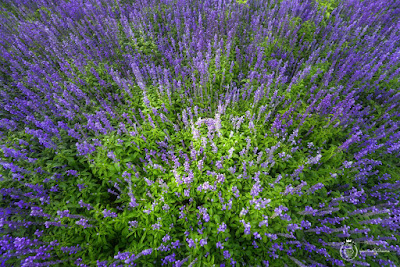Salvia - Sage is characterized by square stems, opposite leaves, flowers formed in false whorls (verticillasters), and aromatic foliage...
Salvia, also called as Sage,Aethiopis, Aethyopys, Aitopsis, Arischrada, Audibertia, Audibertiella, Belospis, Calosphace, Codanthera, Covola, Crolocos, Dorystaechas, Drymosphace, Elelis, Enipea, Epiadena, Euriples, Fenixanthes, Flipanta, Gallitrichum, Glutinaria, Hematodes, Hemisphace, Hemistegia, Horminum, Jungia, Kiosmina, Larnastyra, Lasemia, Leonia, Leonura, Lesemia, Megyathus, Melinum, Melligo, Meriandra, Oboskon, Ormiastis, Ormilis, Perovskia, Piaradena, Plethiosphace, Pleudia, Polakia, Pycnosphace, Ramona, Rhodochlamys, Rhodormis, Rosmarinus, Salviastrum, Schraderia, Sclarea, Sobiso, Sphacopsis, Stenarrhena, Stiefia, Terepis, Zhumeria, is a genus in the Lamiaceae family. This genus was described by Carl Linnaeus in 1753 and was named referring to the herb's healing properties.
IDENTIFY SALVIA - SAGE
Salvia is distributed throughout the Old World and the Americas. It is a plant that requires a large amount of sun and can be commonly found near limestone and in places where the soil is shallow, dry, and rocky. One notable exception is bog sage (Salvia uliginosa), which is native to wet soils in Brazil, Uraguay, and Argentina. Aside from its natural habitat, people cultivate sage all over the world in order to harvest it for its medicinal and cooking purposes.
It can be annual, biennial, or perennial herbaceous plants, along with woody subshrubs. The plants of the genus are characterized by square stems (cross section), opposite leaves, flowers formed in false whorls (verticillasters), and aromatic foliage. Salvia flowers are disposed in terminal or axillary racemes, spikes, panicles, or cymes. The calyx has two lips, the lower deeply two-toothed, the upper three-toothed. The corolla is also two-lipped, the upper hooded, erect or plane and the lower spreading with three lobes.
Sage is also characterized by having two stamens, included or exserted, and fruit containing four ovoid, three-angled nutlets. Hummingbirds, bees, bumblebees, and bee-flies harvest nectar from salvias and thereby act as pollinators.
It is a large genus comprised of about 900 species with over 140 species are used as garden plants, culinary and medicinal herbs, cut flowers, and for habitat gardening. Although about 140 species are in cultivation, only a few salvias are commonly found in commerce and gardens.
SALVIA - SAGE CARE AND CULTURE
Cultural information should only be used as a guide, and should be to be adapted to suit you. Your physical location; where you grow your plants, how much time you have to devote to their care, and many other factors, will need to be taken into account. Only then can you decide on the cultural methods that best suit you and your plants.
Light:
Salvia require full sun, which is generally defined as a minimum of six hours of direct sunlight daily. There are varieties that will also tolerate partial shade. They are facultative long day plants and flower induction occurs more rapidly under long days. They will flower under any photoperiod, but will flower quicker and better under long days.
Until plants become established, some protection from extreme winds and direct, hot sunlight may be necessary. Good air movement is also important.
Temperature:
Sage can grow in USDA zone 5-10. It grows best at the temperature of 16 - 19 °C. Once plants reach a saleable size, they can be moved to an open environment with good air movement. Plan ahead on this step because the plant grow very fast coming out of dormancy and can get leggy very quickly if grown too warm.
Substrate and growing media:
Salvia can be grow in containers but grow best in garden beds. They don't need rich soil, but they must have good drainage. In pots, a mixture of ordinary garden soil mixed with perlite allows water to drain rapidly. The soil pH should be 5.8 - 6.2.
When planting in garden, prepare the bed by turning the soil under to a depth of 6-12, inches removing any debris, and lightly raking as level as possible. The addition of organic matter (leaf mold, compost, well-rotted manure) benefits all gardens and is essential in recently constructed neighborhoods. Dig a hole twice the diameter of the container the plant is in. Remove the plant from its container and place it in the hole so the top of the root ball is level with the soil surface. Space plants 1 to 3 feet apart, depending on the variety. Carefully fill in around the plant and firm the soil gently. Water thoroughly and apply a light mulch layer on top of the soil (1-2 inches) to conserve water and reduce weeds.
Watering:
Sage are very drought tolerant and will do better in drier soil than overly moist soil. Lightly water when the top 2 inches of soil is dry. Keep the soil evenly moist during all stages of growing. The plants requires average amounts of irrigation, and overly wet conditions will promote tall, leggy growth.
Fertilizer:
Salvia are light feeders and only occasionally need fertilizer. A light application of a balanced fertilizer or compost in early spring, after new growth appears, can be sufficient. Keep granular fertilizers away from the plant crown and foliage to avoid burn injury. Use low rates of a slow release, as higher rates may encourage root rots.
Pruning:
Trimming and pinching can be done early when a fall planting is done. Pinching 2 to 4 weeks after transplant in the fall can assist in building a plant that has a thicker form and also give you more flowers spikes per pot. Trimming is not recommended when forcing plants in the spring or on plants that have been freshly planted in the spring from cooled liners.
Remove spent flower spikes to encourage flowering and prevent seed development. Pinching the growing tips of plants can encourage bushiness.
Mulching:
Keep weeds under control during the growing season. Weeds compete with plants for water, space and nutrients, so control them by either cultivating often or use a mulch to prevent their seeds from germinating.
Mulches help retain soil moisture and maintain even soil temperatures. For annuals an organic mulch of shredded leaves lends a natural look to the bed and will improve the soil as it breaks down in time. Always keep mulches off a plant’s stems to prevent possible rot.
Pests and diseases:
The most common insect problem to watch for is the two-spotted Spider Mite. A routine scouting program is recommended to ensure that Whiteflies, Aphids and other greenhouse pests don’t harm the plant as well. Foliar diseases should also be scouted to prevent Botrytis and Crown Rots.
Propagation:
Sage is usually propagated by seeds. Sow the seeds indoors 10-12 weeks before the last frost and keep evenly moist. Seedlings will emerge in 15-21 days at 21-24 °C. As soon as seedlings emerge, provide the temperature of 16-19 °C and plenty of light on a sunny windowsill or grow seedlings 3-4 inches beneath fluorescent plant lights turned on 16 hours per day, off for 8 hours at night. Raise the lights as the plants grow taller. Seedlings do not need much fertilizer, feed when they are 3-4 weeks old using a starter solution (half strength of a complete indoor houseplant food) according to manufacturer’s directions. If you are growing in small cells, you may need to transplant the seedlings to 3 or 4 inch pots when seedlings have at least 2 pairs of true leaves before transplanting to the garden so they have enough room to develop strong roots. Before planting in the garden, accustom young plants to outdoor conditions by moving them to a sheltered place outside for a week. Be sure to protect them from wind and hot sun at first. If frost threatens at night, cover or bring containers indoors, then take them out again in the morning. This hardening off process toughens the plant’s cell structure and reduces transplant shock and scalding.
The plants can also propagated by cuttings. Take cuttings in August or September, from vegetative (non-flowering) branches that are about 3 inches long. Remove the lower leaves and trim each cutting just below a node. You can either start propagating by placing them in water or by putting them in soil. If you opt for cutting propagation in water, just put the cuttings in a vase and add a few inches of water. When rooting cuttings in soil, dip the cut end in rooting hormone, then plant it in moist potting medium. One good medium to try is a 70/30 mix of perlite/vermiculite and potting soil. After three weeks, cuttings should be ready to pot on.
BUY SALVIA - SAGE AND RELATED PRODUCTS
BUY ANOTHERS SPECIES AND VARIETIES OF SALVIA GENUS HERE!
SOME SPECIES AND VARIETIES OF SALVIA WITH CARE TIPS AND CULTURE SHEET:
- Salvia apiana - White sage - Bee sage
- Salvia argentea - Silver sage
- Salvia arizonica - Arizona sage - Desert indigo sage
- Salvia azurea - Blue sage - Prairie sage
- Salvia azurea var. grandiflora - Pitcher sage
- Salvia ballotiflora - Shrubby blue sage - Mejorana
- Salvia brandegeei - Santa Rosa Island sage
- Salvia buchananii - Buchanan's sage
- Salvia cacaliifolia - Guatemalan sage
- Salvia canariensis - Canary Island sage
- Salvia candelabrum - Candelabrum sage
- Salvia canescens var. daghestanica - Caucasus sage
- Salvia carduacea - Thistle sage
- Salvia chamaedryoides - Germander sage
- Salvia clevelandii - Fragrant sage - Cleveland sage
- Salvia coccinea - Scarlet sage - Blood sage
- Salvia divinorum - Diviner's sage
- Salvia elegans - Pineapple sage
- Salvia fruticosa - Greek sage
- Salvia fulgens - Mexican scarlet sage
- Salvia guaranitica - Anise-scented sage
- Salvia hispanica - Chia
- Salvia involucrata - Roseleaf sage
- Salvia jurisicii - Yugoslavian cut leaf sage
- Salvia leucantha - Mexican bush sage
- Salvia microphylla - Baby sage
- Salvia nemorosa - Woodland sage - Balkan clary
- Salvia officinalis - Common sage
- Salvia patens - Gentian sage - Spreading sage
- Salvia pratensis - Meadow clary - Meadow sage
- Salvia rosmarinus - Rosemary
- Salvia sclarea - Clary sage
- Salvia spathacea - Hummingbird sage
- Salvia splendens - Scarlet sage
- Salvia uliginosa - Bog sage
















COMMENTS